Test 2 - Lateral Inhibition & Receptive Fields (2)
1/26
There's no tags or description
Looks like no tags are added yet.
Name | Mastery | Learn | Test | Matching | Spaced |
|---|
No study sessions yet.
27 Terms

what concept is this picture showing?
neural convergence - the process by which multiple neurons send impulses to a single neuron
what are rods good at doing?
peripheral vision
what are cones good at doing?
precision, detailed vision
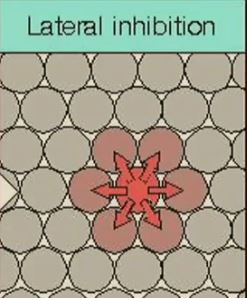
what is lateral inhibition?
when an active neuron diminishes the activity of neighboring neurons
Predict how the rate of firing at neuron A might be affected by these three scenarios. Explain why.
Light shines only on A
Light shines on A + B
Light shines intensely on B but not on A
Normal rate of firing
Diminished rate of firing
Even more diminished
Lateral inhibition is the reason the firing decreases at A for scenario 2 and 3 because when any amount of light get shined on a neighboring neuron, the activity at A will be diminished. This holds especially true when it shines more intensely at B.

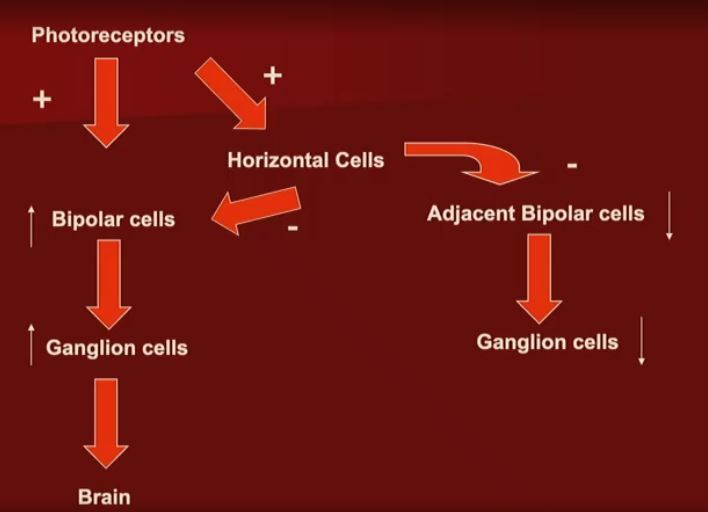
what is the role of horizontal cell in lateral inhibition? where are they located? how do they interact with photoreceptors?
horizontal cells are located near bipolar cells. horizontal cells play the role of an inhibitory cell. when they receive a signal from photoreceptors their job is to inhibit not only the initial bipolar cell but all adjacent bipolar cells. this eventually leads to diminished bipolar cell activity which in turn decreases ganglion cell activity resulting in no talky talky with brain.
Name the three lightness perception phenomena that relate to lateral inhibition
The Hermann Grid
Mach Bands
Simultaneous Contrast
Why does the Hermann Grid effect happen?
Neuron activity at the intersection of the white areas is reduced due to being surrounded by white. The horizontal cells at the white sections are essentially sending inhibiting signals to receptors at the intersections. These inhibiting signals leads to a warped perception of gray at intersection rather than what is actually there, white.
What is Hermann Grid?
seeing an illusion of gray spots in intersections of white areas
what are mach bands?
a false perception of darkness and lightness at the edges of differing shades of grey.
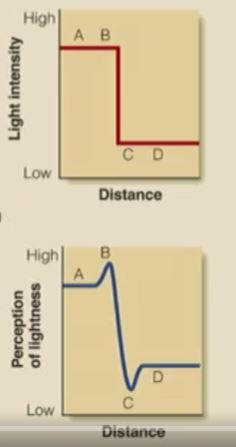
why does the mach band effect happen?
at the edge of the grey shade with greater light intensity, LESS lateral inhibition occurs when positioned next to a darker shade. at the edge of a grey shade with lesser light intensity, MORE lateral inhibition occurs when positioned next to a lighter shade.
what is the benefit of having lateral inhibition?
Lateral inhibition allows for edge detections, allowing us to distinguish objects from one another.
what is simultaneous contrast?
an illusion where an area of color appears as a different brightness or color due to an adjacent area.
why does simultaneous contrast occur?
A shade of color positioned next to a lighter area makes the color appear darker due to MORE lateral inhibition. When a shade of that same color is positioned next to a darker area it appears lighter due to LESS lateral inhibition.
How can lateral inhibition apply to your other senses?
Hearing - In music, can dampen the sounds of all instruments in order to focus on an individual sound.
Touch - When you’re hurt, you can rub around the wound to alleviate the pain but not directly on it.
What is an example of a phenomenon that cannot be explained by lateral inhibition?
white’s illusion
Why does white’s illusion happen?
Exact explanation is unknown. Perception most likely occurs in cortex rather than retina. Our brains think the block’s background are belonging to something else.
what is a receptive field?
an area of receptors that affects firing rate of a given neuron in the circuit
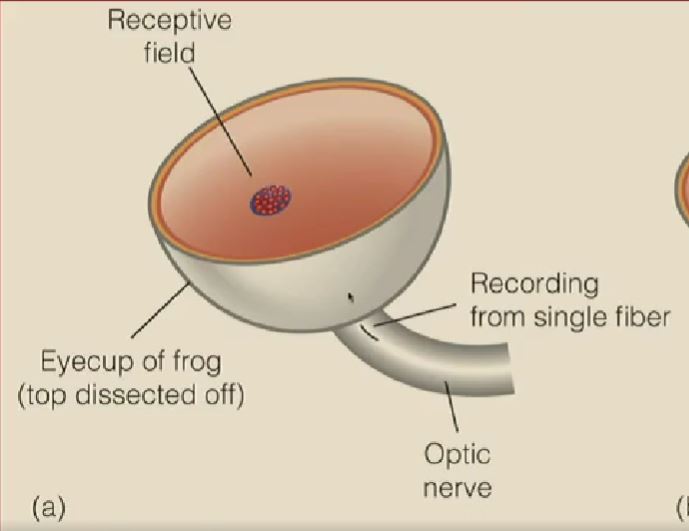
what is center-surround organization of receptive fields? what are the different types?
excitatory center - inhibitory surround
inhibitory center - excitatory surround
This refers to the structure of receptive fields and how it affects firing rate of neurons. For example, in an excitatory center-inhibitory surround, it fires fastest when light is concentrated on the center.
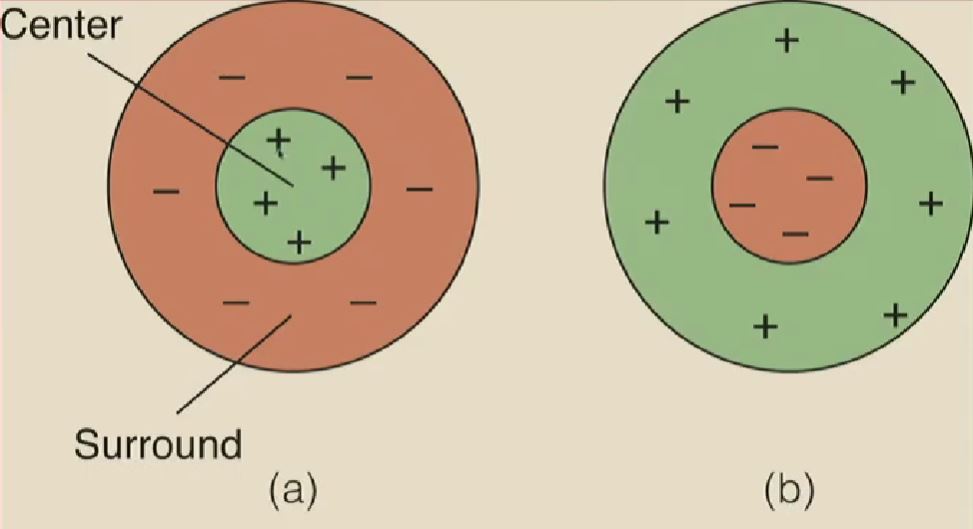
what is the relationship between receptor field size and vision?
large receptive fields = less detailed vision, more neural convergence, more area to pick up stimulus
small receptive fields = more detailed vision, less neural convergence
Does size of receptive field have the same effect in our other senses? If so, explain.
Touch = small receptive fields located on tongue and finger. large receptive fields located on back (two-point discrimination)
What is the path way that signals from the retina travel?
retina < lateral geniculate nucleus (in thalamus) < area v1/striate cortex (in occipital lobe) < pathways in temporal love and parietal lobe < frontal lobe
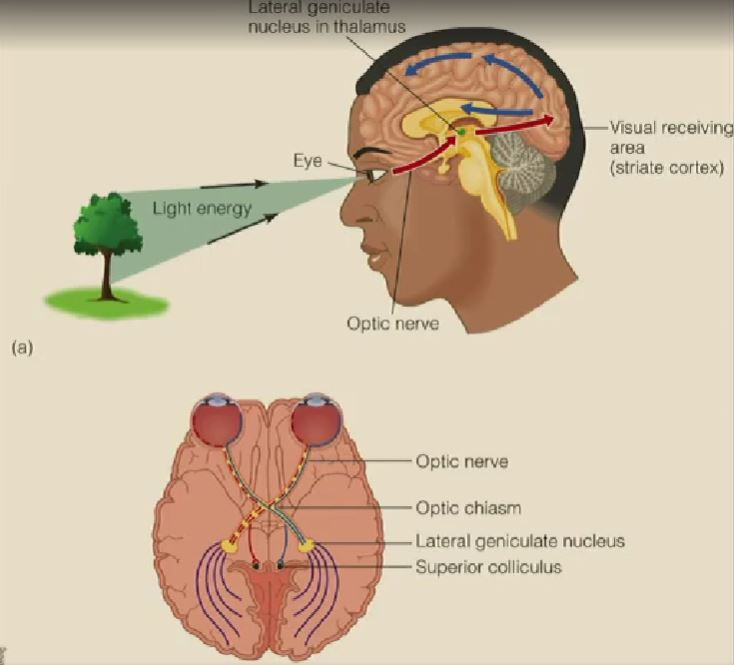
what type of receptive fields do lateral geniculate nucleus’s have?
center-surround receptive fields
Name the three different feature detectors. Where are they located?
Simple cortical cell
Complex Cortical Cell
End-stopped cortical cell
They are located in the visual cortex
What do simple cortical cells respond to? Why do they respond in that way?
Simple cortical cells responds to bars of light in specific orientations. This is because their receptive fields are organized in a side by side manner.
what do complex cortical cells respond to?
They respond to bars of light in specific orientation AND particular direction of movement.
what do end-stopped cortical cells respond to?
They respond to corners, angles, bars of light MOVING in a particular direction.